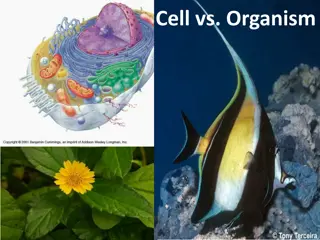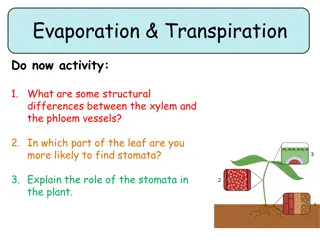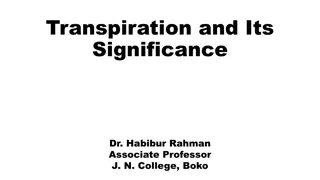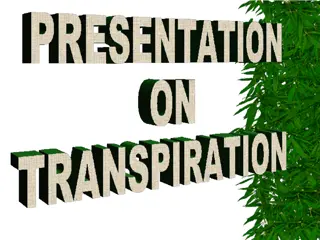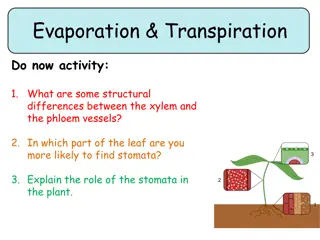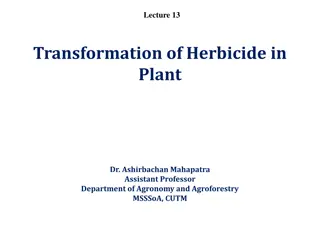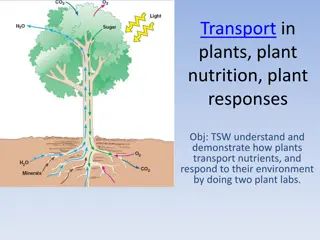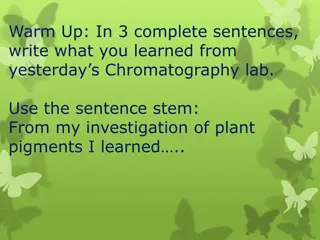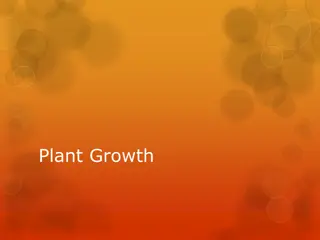Year 9 End of year revision
Learn how plants make their own food and the essential processes of photosynthesis. Discover why photosynthesis is crucial for maintaining oxygen and carbon dioxide levels. Explore leaf structure, chloroplast function, roles of carbon dioxide and water, and the significance of light energy. Uncover
0 views • 26 slides
Understanding Gas Exchange in Cells and Organisms
Gas exchange is vital for cellular respiration and photosynthesis. In organisms, specialized structures like alveoli in lungs and stomata in plants facilitate this process. This exchange occurs through diffusion across moist surfaces with large surface areas. In animals, oxygen is taken up by hemogl
0 views • 40 slides
Understanding Plant Evaporation and Transpiration Processes
Learn about the structural differences between xylem and phloem vessels, the role of stomata in plant leaves, and how water loss occurs through transpiration. Discover how guard cells regulate stomata openings and watch a video explaining transpiration processes in plants. Test your knowledge with s
0 views • 11 slides
Understanding Transpiration in Plants: Importance and Mechanisms
Transpiration is the process in which plants lose water vapor through their aerial parts, playing a crucial role in their overall functioning. This loss of water occurs mainly through stomata, lenticels, and the cuticle of leaves and stems. Different types of transpiration like stomatal, lenticular,
0 views • 19 slides
Understanding Transpiration and Gas Exchange in Plants
Transpiration is the evaporation of water from plants, mainly occurring through the leaves' stomata. Plants exchange gases like CO2 and O2 through various parts, without specialized organs. The process aids in photosynthesis, respiration, and cooling, demonstrating the importance of transpiration in
0 views • 22 slides
Understanding Transpiration Process in Plants
Explore the intricate process of transpiration in plants, focusing on the roles of stomata, guard cells, and water movement. Learn about the structural differences between xylem and phloem vessels, stomata's function in regulating gas exchange, and how environmental factors impact transpiration rate
0 views • 14 slides
Herbicide Absorption and Translocation Mechanisms in Plants
Herbicides need to be effectively absorbed and translocated within plants to interfere with physiological and biochemical processes. Soil-applied herbicides are absorbed by roots, shoots, and seeds through different mechanisms, while foliage-applied herbicides enter through the cuticle, stomata, and
0 views • 7 slides
Understanding Plant Transport, Nutrition, and Responses
The process of how plants transport nutrients and respond to their environment is demonstrated through labs focusing on protein transport, water absorption by roots, and control of transpiration using mechanisms like diffusion, osmosis, and symbiotic relationships with fungi. Various components in p
0 views • 28 slides
Adaptations of Xerophytes in Different Habitats
Xerophytes, plants adapted to dry habitats, possess specific adaptations to prevent excessive water loss such as sunken stomata, presence of hairs, thick waxy cuticle, and rolled leaves. These adaptations help xerophytes thrive in arid conditions, maintaining humid air around stomata and maximizing
0 views • 13 slides
Understanding Photosynthesis and Stomata through Microscopic Observations
Explore the role of stomata in photosynthesis by examining leaf surfaces under a microscope, identifying guard cells and stomata structures. Learn how stomata regulate gas exchange and impact plant growth based on their concentration and environmental conditions.
0 views • 10 slides
Understanding Plant Cell Growth Mechanisms
Explore the fascinating world of plant cell growth with a focus on specialized cells like guard cells for gas exchange, meristematic cells for differentiation, and apical meristems for plant growth. Learn how stomata function to regulate water loss and support photosynthesis, and uncover the key pro
0 views • 17 slides

